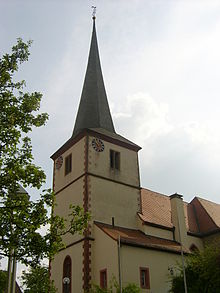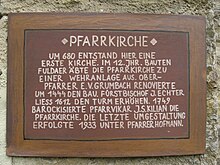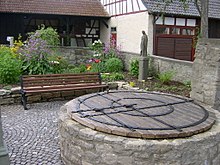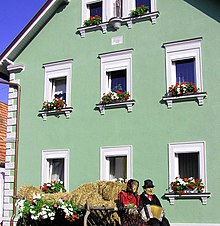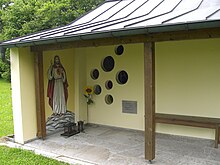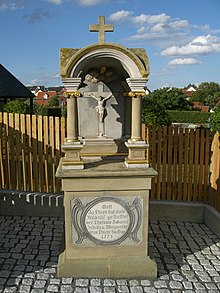Greßthal (waterless)
|
Greßthal
Community Waterless
|
|
|---|---|
| Coordinates: 50 ° 4 ′ 36 ″ N , 10 ° 2 ′ 19 ″ E | |
| Height : | 302 m |
| Residents : | 591 (1988) |
| Incorporation : | May 1, 1978 |
| Postal code : | 97535 |
| Area code : | 09726 |
Greßthal is part of the municipality Wasserlosen in the Lower Franconian district of Schweinfurt in Bavaria .
geography
Greßthal has around 750 inhabitants. Together with the villages of Rütschenhausen , Schwemmelsbach , Wasserlosen , Brebersdorf and Kaisten , the village is part of the geographical unit of the Reichtal, which was flooded by a huge stream of water during the Ice Age and which also owes its landscape character to this.
history
Greßthal was first mentioned on July 4th, 804. However, the first settlements are from around 5000 BC. Demonstrable. Between 700 and 450 BC The Celtic settlement emerged as the origin of Greßthal. Numerous barrows give evidence of this era. Christianization began around the year 600 through the Franks. The missionaries erected a first cross on a pagan cult site. The first church was built around 680. The Schweinfurt counts founded a parish in the 8th century, which was equipped with a large parish. On average, the property of a parish at that time was around 90 acres , the Greßthaler parish initially had around 160 acres of fields, and nobles gave them tithe rights. In the 12th century the parish received 90 percent of the tithe levies in Reichtal. After numerous disputes between the Abbot of Fulda and the Bishop of Würzburg, Greßthal came into the possession of the Würzburg Monastery in 1376 . For All Saints' Day in 1443, Bishop Gottfried IV. Schenk of Limpurg raised Greßthal to the position of the episcopal upper parish . Now a canon, who was appointed by the bishop, ruled in Greßthal and the branches as senior pastor. Nothing changed until secularization .
After secularization, Greßthal developed into a village with many craft businesses, traders and inns.
On April 6 and 7, 1945 the village was partially destroyed by US artillery shelling.
The independent municipality of Greßthal was incorporated into the new municipality of Wasserlosen on May 1, 1978 together with seven other localities.
Mayor of the once independent municipality of Greßthal

Attractions
Parish Church of St. Bartholomew
- Main article: Parish Church of St. Bartholomew (Greßthal)
There is nothing left of the first church from around 680, which was consecrated to the Holy Apostle Matthias. In the period that followed, the abbots of Fulda carried out renovations.
The first senior pastor of Greßthal, Eberhard von Grumbach, renovated the parish church around 1450. He installed Saint Bartholomew as the parish patron. The next construction phase took place under Prince-Bishop Julius Echter during the Counter-Reformation with the consecration on Martini Day in 1614.
The baroque transformation of the parish church began in 1749 under parish vicar Johann Sigismund Kilian. After the west gable was demolished, the nave was extended. The interior of the parish church was provided with simple but elegant stucco. The baroque altars were added in 1761. In 1868, the interior was redesigned under Pastor Karl Josef Pabst. The baroque altars were replaced by neo-Romanesque ones. The room was renovated and richly painted in this style.
After long preliminary planning, the foundation stone for the necessary reconstruction of the parish church was laid on May 16, 1933. On October 9, 1933, Bishop Matthias Ehrenfried was able to consecrate the church interior with its new altars. The frescoes come from the Aschaffenburg painter Alois Bergmann-Franken . The Way of the Cross came from his workshop in 1956. The altars were made by the goldsmith Josef Amberg. The pulpit is Josef Wiesner's masterpiece.
Rectory
The pastor Erhard von Lichtenstein built the former rectory in 1596 as a private country residence. In addition to the residential and administrative house, the buildings belonging to the court from the 18th century were part of it. Parish vicar Johann Sigismund Kilian had the farm buildings redone in 1743. The parish uses the romantic courtyard as a meeting place on various occasions.
Town houses
The old town center of Greßthal is characterized by a large number of town houses from the 19th century. These buildings bear witness to the beginning prosperity of the bourgeoisie. The craft was rediscovered in the middle of the 19th century. After the place had lost its importance with the secularization , it experienced a new bloom again through craft and trade.
The buildings were built in classic half-timbered construction, for example the Schwarzer Adler inn on the Pfarrberg, but also with massive sandstone gables.
Another inn, the Golden Star, has less of a half-timbered structure, but a classic sandstone gable with heavily profiled cornices and pilaster strips . Many of these houses were renovated in view of the local anniversary in 2004.
Lady Chapel
Alois Wiesner built the Marienkapelle on the upper Pfarrberg in 1956. Inside it hides a carved Madonna . The chapel is privately owned. Around 2000 it was extensively renovated by Leonhard Hofmann.
Plaque
A memorial plaque in the center of the village is a warning reminder of the Second World War. On April 7, 1945 Greßthal was under heavy attack from the Americans. The stone tablet on Rathausplatz commemorates Alfred Kubanek, who fell there.
Natural monuments
- Pear tree on the Lerchenberg - with a trunk circumference of almost five meters, one of the strongest pear trees in Germany.
Wayside shrines
Museums and culture
Parish Museum Greßthal
Today's parish museum once served the Greßthal parish vicars as a residence and office. The building was built in 1596 by pastor Erhard von Lichtenstein, who used it as a private country residence. He bequeathed the building to the upper parish and decreed that the parish vicars should live there. Until 1983 the priests who worked for the parish lived there. After extensive restoration of the property between 2002 and 2004, the parish house serves as a museum building. The reception hall, the library and the house chapel on the upper floor were furnished according to the earlier tradition as part of this renovation measure. On the ground floor, the archaeological collection gives an insight into the everyday life of the first Greßthal farmers around 7000 years ago. Works of art from around 550 years of parish history can be seen on the upper floor.
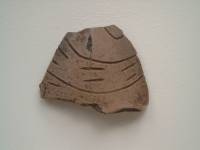
Fragment from the time of the linear ceramicists
|
||||
societies
- DJK Greßthal e. V.
- Volunteer firefighter
- music Society
- Fruit and horticultural association
- Soldier and reservist comradeship
Economy and Infrastructure
Economy including agriculture and forestry
In addition to restaurants, grocery stores, craft businesses and service companies, Greßthal has an industrial park. In forestry and agriculture only a few employees are still full-time. In addition to local companies, the cities of Schweinfurt and Würzburg offer jobs.
traffic
Greßal is connected to the A 7 via the Wasserlosen driveway . The A 3 and the A 70 can be reached via the A 7. The state road 2293 with the diversions U 57 and U 60 leads through Greßthal.
There is a bus connection (No. 8139) operated by Omnibus Verkehr Franken GmbH (OVF) to Schweinfurt.
Public facilities
- The town hall of the large municipality of Wasserlosen is located in Greßthal. Since the regional reform in 1978, the administration has been housed in a former schoolhouse. At the end of the 1980s, a new building was built, which could be moved into in 1991.
- The Greßthal parish library is located on the first floor of the parish hall. Themed evenings are also held in the library in cooperation with the Schweinfurt adult education center.
education
The kindergarten, which the children from Schwemmelsbach and Rütschenhausen also attend, is sponsored by the Catholic Church Foundation Greßthal. Until 1978, the Redeemer Sisters from Würzburg looked after the kindergarten. A new building on Karl-Ruppert-Straße has been available since 1984 and offers space for three groups.
literature
- Florian Prosch, Greßthal - In the heart of the Reichtal, Obertshausen 2004.
- Alois Gößmann, Wasserlosen - and its districts, Schweinfurt 1988.
- Codex Diplomaticus Fuldensis .
Individual evidence
- ^ Federal Statistical Office (ed.): Historical municipality directory for the Federal Republic of Germany. Name, border and key number changes in municipalities, counties and administrative districts from May 27, 1970 to December 31, 1982 . W. Kohlhammer GmbH, Stuttgart / Mainz 1983, ISBN 3-17-003263-1 , p. 753 .


